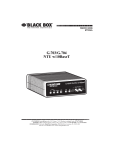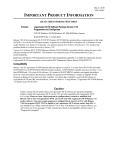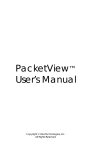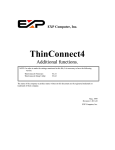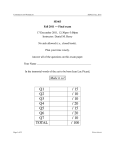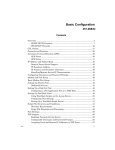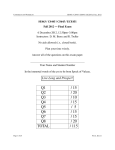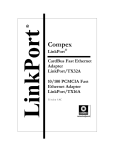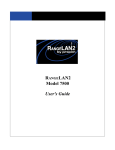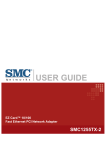Download PPP User`s Manual - Klos Technologies, Inc
Transcript
PPP User's Manual Copyright Klos Technologies, Inc. All Rights Reserved Legal Notice Information in this document is subject to change without notice and does not represent a commitment on the part of Klos Technologies, Inc. The Software described in this document is furnished under the Software License Agreement set forth in Appendix C of this document. The Software may be used or copied only in accordance with the terms of the License. The purchaser may make one copy of the software for back-up purposes, but no part of this User's Manual may be reproduced, stored in a retrieval system, or transmitted in any form or by any means electronic or mechanical, including photocopying and recording for any purpose other than the purchaser's personal use, without the prior written permission of Klos Technologies, Inc. Trademarks IBM-PC® and IBM-AT® are registered trademarks of International Business Machines Corporation. NetWare® is a registered trademark of Novell, Inc. Windows® is a registered trademark of Microsoft Inc. RSA Data Security, Inc. MD5 Message-Digest Algorithm Copyright © 1991-2, RSA Data Security, Inc. All rights reserved. Other brand and product names are trademarks or registered trademarks of their respective holders. © Copyright, Klos Technologies, Inc. All Rights Reserved Table of Contents Introduction .................................................................................... 1 Product Description ..................................................................... 1 System Requirements .................................................................. 1 System Limitations ...................................................................... 1 Customer Support ........................................................................ 1 Installation...................................................................................... 2 Installing PPP .............................................................................. 2 Installing Guardian for Windows. ............................................... 2 Using PPP with Netware*.............................................................. 3 Remote Dial-in LAN Access ....................................................... 3 Dialing the default CURRENT profile ..................................... 3 Dialing other user-defined profiles ........................................... 3 Terminating Connections ............................................................ 4 Manually Loading PPP................................................................ 4 Manually Unloading PPP ............................................................ 4 Configuration and Support Utilities............................................... 5 FIND_COM................................................................................. 5 PPPMenu ..................................................................................... 5 Command Line Options ............................................................ 6 The Main Menu ........................................................................ 6 Connect................................................................................... 6 Disconnect.............................................................................. 7 Status Displays ....................................................................... 7 Hang-up .................................................................................. 7 Terminal Mode....................................................................... 7 Exit ......................................................................................... 7 The Connect/Configure Menu .................................................. 7 There is a limit of 100 profiles.Port ....................................... 8 Modem.................................................................................... 8 Scripting ................................................................................. 8 LCP Parameters...................................................................... 8 IP Parameters.......................................................................... 8 IPX Parameters....................................................................... 8 Authentication ........................................................................ 8 The Port Menu .......................................................................... 8 I/O Port ................................................................................... 9 i Interrupt .................................................................................. 9 Baud Rate ............................................................................... 9 Flow Control .......................................................................... 9 Listen.................................................................................... 10 Open Type ............................................................................ 10 Connection Type .................................................................. 10 Frame Type........................................................................... 10 The Modem Menu................................................................... 11 Phone Number...................................................................... 11 Modem Name ....................................................................... 11 Command Strings Menu....................................................... 11 Initialization String1 .......................................................... 11 Initialization String2 .......................................................... 11 Initialization String3 .......................................................... 11 Dialing Prefix..................................................................... 12 Answer String .................................................................... 12 Hang-up String................................................................... 12 Timers/Counters ................................................................... 12 Dial Retries ........................................................................ 12 Connection Time Out ........................................................ 12 Pause Time......................................................................... 12 Inactivity Time................................................................... 13 Simple Scripting .................................................................. 13 The LCP Parameters Menu..................................................... 14 Maximum Receive Unit ....................................................... 14 Async-Control Map.............................................................. 14 Magic Number...................................................................... 15 Protocol Compression .......................................................... 15 Address/Control Compression ............................................. 15 The IP Parameters Menu......................................................... 16 Enable/Disable IP ................................................................. 16 Header Compression ............................................................ 16 IP Address ............................................................................ 16 The IPX Parameters Menu...................................................... 16 Enable/Disable IPX .............................................................. 17 Header Compression ............................................................ 17 Node Address ....................................................................... 17 Network Number..................................................................... 17 ii The Authentication Menu ....................................................... 17 PPPState .................................................................................... 18 Command Line Options .......................................................... 18 Guardian .................................................................................... 18 Guardian for DOS ................................................................... 19 Command Line Options ....................................................... 19 Guardian for Windows............................................................ 19 IP Stub ....................................................................................... 19 Command Line Options ....................................................... 19 Files .............................................................................................. 20 NET.CFG................................................................................... 20 Configuration Options ............................................................ 20 ACCM .................................................................................. 21 ACCOMP ............................................................................. 22 AUTHEN CHAP .................................................................. 22 AUTHEN PAP ..................................................................... 22 BAUD................................................................................... 23 CIPX..................................................................................... 23 CONNECT[ION] ................................................................. 24 CONNECT[ION] Inactivity ................................................. 24 CONNECT[ION] Pause ....................................................... 25 CONNECT[ION] Retries ..................................................... 25 CONNECT[ION] Timeout................................................... 25 COUNTERS LCP................................................................. 25 COUNTERS IPCP................................................................ 25 COUNTERS IPXCP............................................................. 25 DIAL..................................................................................... 26 DIRECT................................................................................ 26 FLOW CONTROL............................................................... 27 FRAME ................................................................................ 27 INT ....................................................................................... 27 IPADDR ............................................................................... 27 IPCP...................................................................................... 28 IPXCP................................................................................... 28 LISTEN ................................................................................ 28 MAGIC NUMBER............................................................... 28 MODEM ANSWER............................................................. 28 MODEM DIAL .................................................................... 29 iii MODEM HANGUP ............................................................. 29 MODEM INIT | INIT1 ......................................................... 29 MODEM INIT2.................................................................... 29 MODEM INIT3.................................................................... 29 MODEM NAME.................................................................. 30 MRU - Maximum Receive Unit ........................................... 30 NETWORK ADDRESS....................................................... 30 NODE ADDRESS................................................................ 31 OPEN.................................................................................... 31 PCOMP ................................................................................ 31 PORT.................................................................................... 32 TCPIPCOMP........................................................................ 32 Glossary........................................................................................ 34 Appendix A - Exit Codes ............................................................. 36 Appendix B - Common Problems ................................................ 37 Appendix C -Specific Application Setups ................................... 39 Chameleon ................................................................................. 39 FTP Software PC/TCP .............................................................. 39 Kali ............................................................................................ 39 Lan Workplace for DOS............................................................ 40 Using PPP with Netware ........................................................... 40 Remote Dial-in LAN Access................................................ 40 Dialing the default CURRENT profile................................. 40 Dialing other user-defined profiles ...................................... 40 Terminating Connections ..................................................... 41 Trumpet WINSOCK.................................................................. 41 Appendix D -Error Messages....................................................... 42 Appendix E - Software License Agreement................................. 44 iv Introduction Product Description PPP is a software product that implements the Point-to-Point Protocol in a Novell ODI driver for IBM-compatible personal computers. Using an asynchronous serial communications port on a PC, the software supports the PPP (Point-to-Point Protocol, RFC 1548, December 1993) specification, including LCP (Link Control Protocol, RFC 1548, December 1993), IPCP (IP Control Protocol, RFC 1332, May 1992) and IPXCP (IPX Control Protocol, RFC 1552, December 1993). The software conforms to the ODI (Open Datalink Interface) specification, allowing the PPP link to be used as a network connection, supporting both IP and IPX traffic. PPP also supports multiple user defined configuration profiles. These profiles allow PPP to be quickly reconfigured to connect to any number of remote networks. The CURRENT profile always provides the configuration currently loaded. System Requirements PPP requires an IBM or compatible PC/XT/AT or PS/2 system running DOS version 3.00 or above. A hard disk and 640K base memory is recommended, but not required. At least one available serial port, using either an NS8250, NS16450, NS16550, TI16550C, ST16650 or compatible serial communications controller is also required. System Limitations PPP is a Terminate-and-Stay-Resident (TSR) program that requires Novell LSL to be loaded. PPP supports the IP and IPX protocols. It is not recommended that PPP be used at baud rates above 19200 without a 16550 or 16650 serial communications controller, or on low speed systems. It is recommended that any system using PPP with WINDOWS use only 16550 or 16650 type serial communications controller. Customer Support PPP support is available from Klos Technologies, Inc. at (607) 753-0568 between 9:00 AM and 5:00 PM EST. Klos Technologies, Inc. PPP 1 07/05/99 Support is also available by emailing questions to [email protected] Installation Installing PPP Place the PPP diskette into a floppy drive and switch to that drive. For example, if the floppy is in the A: drive, switch to the A: drive from the DOS prompt. Then execute the INSTALL program by entering "INSTALL" followed by ENTER at the DOS command prompt. INSTALL will search each directory in the system PATH for LSL.COM, with the intent of installing all associated PPP files in the same directory. Whether or not LSL.COM is located, the user will be prompted to verify the desired location for the installation of the PPP files. Then INSTALL will copy the files from the floppy to the specified directory. If a file in the target directory already exists with the same name as a file being installed, a message will be displayed indicating the conflict, and the user will be prompted as to what action should be taken at that point. After the PPP files have been copied to the target directory, INSTALL will attempt to locate the current NET.CFG file. It firsts checks to see if LSL is loaded, if LSL is located then INSTALL will request the full name of the NET.CFG file from LSL. If LSL is not loaded, then INSTALL will search the PATH for the NET.CFG file. Whether or not INSTALL is able to automatically locate NET.CFG, the user will be prompted to verify the desired directory in which the NET.CFG file will reside. INSTALL will then allow the user to configure the PPP driver and update the NET.CFG file accordingly. Installing Guardian for Windows. From the Program Manager, select New from the File Menu. Then select Program Item and click the OK button. Next enter "Guardian" into the description field. Click the "Browse" button and select the Guardian executable file, ktiguard.exe. Klos Technologies, Inc. PPP 2 07/05/99 Using PPP with Netware* Remote Dial-in LAN Access A batch file called dialin.bat is provided to automate the process of dialing into a remote LAN. An optional phone number can be provided on the command line for dialin.bat. When the dialin.bat batch file loads the PPP driver, if the USERID specified in the CURRENT profile requires a password, the user will be prompted to enter the proper password. The syntax of the dialin.bat batch file is shown below. DIALIN [phone number] Dialing the default CURRENT profile To dial the default CURRENT configuration, enter DIALIN followed by the phone number to dial. If a phone number is provided, dialin.bat will use the CURRENT configuration from net.cfg and will load LSL and the PPP driver, dial the phone number to establish a modem connection, establish a PPP connection and authenticate the user dialing-in (if authentication is enable), and will load the IPXODI and NETX drivers to access the remote Novell LAN. The dialin.bat batch file provides a single command in which to establish a remote PPP connection. The user can abort the dialin.bat batch file at any time by entering the <ESC> key. Dialing other user-defined profiles If the phone number is not provided, the dialin.bat batch file will load LSL and the PPP driver, and start the PPPMenu utility. From the PPPMenu utility the user can select several optional menus, including menus to dial and open a connection, to select and view statistics and status information, to change profile configurations, to enter the Terminal Emulator mode, or to simply Exit and unload the PPP driver and LSL. Because the user is placed in the * Refer to Appendix C for other common configurations. Klos Technologies, Inc. PPP 3 07/05/99 PPPMenu utility, any user-defined profile can be selected to establish a connection. Please refer to the PPPMenu description under the Configuration and Support Utilities section in this document. Terminating Connections A batch file called hangup.bat is provided to automate the termination of a PPP connection and to break the modem connection established to the remote LAN. The syntax of the hangup.bat batch file is simply HANGUP The hangup.bat batch file will terminate the PPP connection, hang-up the modem connection, and unload NETX , IPXODI, PPP and LSL as necessary. This batch file provides a single command in which to shut down the link to a remote LAN. Manually Loading PPP PPP is a Novell compatible ODI driver. This requires that LSL be loaded before PPP. After loading PPP, PPPMenu may be used to establish a connection with the network then IPXODI and NETX must be loaded to provide access to a Novell network. The following provides an example of loading PPP for access to a Novell network: LSL PPP PPPMENU IPXODI NETX Note: When PPP is loaded the user will be prompted for a password if the USERID in the Authentication field in net.cfg requires a password. It might be useful to create a batch file (i.e. net.bat) that would contain the commands necessary to start the network operation. Manually Unloading PPP The PPP connection must first be disconnected from the remote network and, if a modem is in use, the phone link hung-up. Then Klos Technologies, Inc. PPP 4 07/05/99 PPP may be removed from memory by first removing NETX, IPXODI and then PPP. After unloading PPP, it is usually advisable to remove LSL also. The following commands provide an example of unloading PPP: PPPMENU NETX IPXODI PPP LSL /Hangup U U U U Configuration and Support Utilities FIND_COM Find_com is an included utility that can be used to detect serial ports and their IRQs. It can also be used to detect conflicts. Find_com is run from the DOS prompt. Find_com checks all standard COM ports or ports specified on the command line for available serial ports. If a serial port is found, the UART type is identified with its IRQ. If either the UART or the IRQ is "Unknown" than a conflict exists or the UART is non-standard. More than one port may be specified on the command line. FIND_COM [/][H|?] [/][P####] . . . [/][P####] H or ? will display a help screen P#### Find_com will check the hexadecimal base port address given When used in a batch files, find_com returns the number of COM ports found as the exit code. WARNING: Do not run find_com under Windows. It will cause Windows to crash. PPPMenu PPPMENU [<phone number>] [/Connect] [/Disconnect] [/Hangup] Klos Technologies, Inc. PPP 5 07/05/99 Command Line Options PPPMenu supports several command line options that allow you to control the initial state of PPP when started. After completing the specified option PPPMenu returns to DOS. <phone number> The phone number is added to the CURRENT configuration and is called immediately. An attempt is then made to open a PPP connection. /Connect An attempt is made to establish a PPP connection with the current configuration. /Disconnect If PPP is currently connected the connection is terminated. /Hangup If PPP is currently connected the connection is broken then the modem is commanded to hang-up the telephone. If no command line options are specified and the LSL and PPP drivers are loaded PPPMenu displays the Main Menu and waits for operator action. When PPP is not loaded, the Profile List menu is displayed. The Profile List menu is the same menu as the menu received when the Connect option is selected from the Main Menu. If PPP is not loaded it is assumed the user only wants to alter user profile configurations. PPPMenu uses a file called phone.dat to store the connection profiles. This file must be in the same directory as the PPPMenu executable. If the file does not exist, it will be created automatically when PPPMenu is loaded. The Main Menu The Main Menu provides a standard control interface for PPP. The menu options are as follows: Connect Connect is only displayed if PPP is not currently connected. Selecting Connect provides a list of profiles. Upon making a selection the profile is made current and a connection is Klos Technologies, Inc. PPP 6 07/05/99 attempted. If a modem is specified in the profile and a phone number is provided a call is placed. After the phone connection is established PPP is started. Disconnect The Disconnect selection is displayed if an open connection exists. It will shutdown PPP and disconnect from the peer machine. If a modem is used, the telephone is hung up. Disconnecting the PPP session does not unload any of the network drivers. Status Displays This selection toggles between providing a status only window and a real-time statistics and status windows. Statistics displays a window on the bottom of the display that provides real-time connection statistics specific to PPP, LCP, IPCP, and IPXCP connection status as well as modem signal status. Hang-up This selection commands the modem to hang up the telephone. Terminal Mode This option provides the ability to communicate with the modem or the remote machine directly. After this communication is complete <Alt-X> will terminate Terminal Mode and <Alt-S> will terminate Terminal Mode and begin PPP. This option is only available when the profile connection type is set to a modem. Exit This option exits the PPPMenu program. The Connect/Configure Menu The Connect/Configure Menu allows PPP profiles to be modified as needed. The Configuration Profile List menu is displayed with the names of all profiles. Upon selecting a profile to view or modify, the menus for all configuration options are shown. To Klos Technologies, Inc. PPP 7 07/05/99 insert a new profile, use the <INSERT> key. The new profile will initially be based on the current net.cfg file. To delete a profile, highlight the profile and use the <DELETE> key. Changes to the CURRENT configuration are made immediately to PPP, if loaded, and to the net.cfg. There is a limit of 100 profiles.Port Port provides a set of menus which allow parameters associated with the serial port used by PPP to be configured. Modem Modem provides a set of menus which allow modem specific parameters to be configured. Scripting Scripting allows for up to eight scripts to control the connection before PPP engages. LCP Parameters LCP Parameters provides for the configuration of the Link Control Protocol specific parameters. IP Parameters IP Parameters provides for the configuration of the Internet Protocol specific parameters. IPX Parameters IPX Parameters provides for the configuration of the Internet Packet Exchange Protocol specific parameters. Authentication This menu provides for the configuration of the USERID and Password used to authenticate the user via either the Password Authentication Protocol (PAP) or the Challenge-Handshake Authentication Protocol. The Port Menu The Port Menu allows configuration of the port specific parameters. Klos Technologies, Inc. PPP 8 07/05/99 I/O Port I/O Port selects the serial port PPP will use. The port may be one of the standard serial ports; COM1, COM2, COM3 or COM4. If a non standard serial port is used, the base I/O address for the port may be specified by selecting the "SPECIAL" parameter. If a base I/O port address is entered, it must be of the form hhhh where each 'h' is a hexadecimal digit. Note: Using a standard serial port will set both the base I/O port and the interrupt line for port. Interrupt The Interrupt configuration option provides the interrupt level to be used by the serial controller. This line must match the hardware configuration of the selected serial port. The interrupt line specified must be between 2 and 15, inclusive. Note: Some serial ports attempt to share interrupts. Not all serial port hardware supports shared interrupts. Consult your hardware manual for specific details. Baud Rate This option selects the communication speed for the serial port. The default value is 9600 bits per second but any of the following are acceptable: 300, 600, 1200, 2400, 4800, 9600, 14400, 19200, 28800, 38400, 57600 or 115200. Flow Control The Flow Control option sets the mechanism used to control the flow of information. Flow control may be done in hardware, software or not at all. If flow control is provided by software, XON and XOFF are used. Further, the Asynchronous Control Character Map is set to force escape sequences for XOFF and XON bytes encountered in packets. Hardware flow control uses the RTS/CTS signals of the serial port and does not effect any packet bytes. It is also possible to have no flow control or both hardware and software flow Klos Technologies, Inc. PPP 9 07/05/99 control enabled. Hardware flow control should usually be selected when connecting via a modem. Listen Listen sets PPP to automatically answer the phone when it rings (AUTO-ANSWER) or ignore the ring signal and wait for operator interaction (DON'T ANSWER). Open Type The Open Type configuration option provides a way to designate which machine will initiate a connection. The machine configured as PASSIVE will not actively attempt to open a connection with the peer machine. The CONNECT program may be used to attempt to initiate a connection at anytime after PPP is loaded. A machine configured as ACTIVE will attempt to open a connection with the peer machine immediately upon loading. If no peer is available it will time-out and cease attempting to make a connection unless restarted by the CONNECT program, or when an active peer initiates a connection. Default: Allowable: ACTIVE ACTIVE or PASSIVE Connection Type Connection Type is used to determine if the serial port is directly connected to the peer (Direct) or if the connection is through a modem (Modem). Modem connections may also be configured to automatically dial when PPP is loaded (Modem - Auto Dial), automatically dial when network access is required (Modem - Demand Dial), or to drop into terminal mode after dialing. Frame Type Frame type is used to determine the frame type to be used. The options are PPP, Ethernet_802.3, Ethernet_802.2, Ethernet_SNAP, and Ethernet_II. If the frame type is changed Klos Technologies, Inc. PPP 10 07/05/99 and PPP is already loaded, then PPP will need to be unloaded then loaded before the change will take place. The Modem Menu The Modem Menu allows configuration of the modem specific parameters. Phone Number The number to be called to establish a connection. This phone number may contain any characters acceptable to the modem, and may be upto 60 characters in length. Alphabetic characters that are enclosed within double quote marks are converted to their numerical equivalents. Example: 1-603-429-"Frog" will be translated to 1-603-429-3764. Modem Name Modem Name saves a name associated with the modem. This name is just stored and is not used at this time. Command Strings Menu The Command Strings Menu allows configuration of the modem command strings. Initialization String1 Initialization String2 Initialization String3 The Initialization Strings are used to initialize the modem before each attempt to establish a connection. The default Initialization Strings should be sufficient for most Hayes compatible modems. Consult the modem manual for specific details about modem configuration. The modem initialization strings should set the modem as follows: factory defaults, plus hardware flow control, no echo, response messages enabled, attention when DTR dropped, escape character (S2) is set to 128, auto negotiate data compression and auto negotiate error correction. Each initialization string can be 40 characters in length. Klos Technologies, Inc. PPP 11 07/05/99 Dialing Prefix This string is sent to the modem before the phone number. For most modems this string is "ATDT" for touch tone dialing and "ATDP" for pulse dialing. The dialing prefix can be 12 characters in length. Answer String This string is used to direct the modem to automatically answer the phone when it rings. The normal value for this string is "ATA". The answer string can be 12 characters in length. Hang-up String This string is sent to the modem to direct it to hang up the telephone line. This value is normally "ATH0". The hang-up string can be 12 characters in length. Timers/Counters The Timers/Counters Menu allows configuration of the timers and counters used to establish and maintain connections via modem. Dial Retries Dial Retries is the number of times PPP should attempt to call the remote system before giving up. The default is 10 retries. Connection Time Out Connection Time Out is the time PPP waits after dialing for the remote system modem to answer the telephone and establish the modem connection. If PPP fails to receive a Carrier Detect (CD) from the modem before the time period has expired it will terminate the call and wait Pause Time to try again if the Dial Retries have not expired. Pause Time Pause Time is the time PPP waits between unsuccessful attempts to call the remote system. After the Pause Time time-out PPP will try again to place the telephone call to the Klos Technologies, Inc. PPP 12 07/05/99 remote system if the Dial Retries have not expired. The default Pause Time is 5 seconds. Inactivity Time The Inactivity Time provides the time, in minutes, that PPP will maintain an inactive connection when in demand dial mode. If no packets are sent for the period defined, PPP will terminate the connection and hang-up the telephone. When another packet is posted, PPP will attempt to re-establish the connection. The default is 5 minutes. Simple Scripting After the modems have established the physical connection, PPP allows for up to eight scripts to be used to ease the connection process. Each script contains a pair of strings and a time limit. These scripts are executed in numerical order. Scripting ends when the first PPP packet is received or after the last script has completed. Each script consists of the expected string, the response string, and the response timeout. The expected string is what PPP waits for from the host. The response string is what PPP will respond with for the given expected string. The response timeout is the time in seconds that PPP waits for the expected string. For the response string, escape codes can be entered to substitute the User ID or Password from the Authentication menu, the telephone number specified under the Modem menu, or the Node Address from the IPX Menu. $u for user id $p for password $t for telephone number $n for node address Klos Technologies, Inc. PPP 13 07/05/99 Most standard C escape sequences are also supported \a alert (bell) \b backspace \f formfeed \n newline (linefeed) ***NOT a carriage return*** \r carriage return \t horizontal tab \v vertical tab \" double quote \\ Backslash \0-7 octol number \x hexadecimal number Note: If an expected or response string does not end with a carriage return ("\r") then the user will be asked if the string requires a carriage return. The LCP Parameters Menu The LCP Parameters Menu allows configuration of the Link Control Protocol specific parameters. Maximum Receive Unit The Maximum Receive Unit sets the maximum number of bytes in a packet that can be received by PPP. The maximum receive unit must be greater than or equal to 576 and less than or equal to 2000. The default value is 1500. Note: Maximum Receive Unit must be less than or equal to the buffer size defined for LSL. The LSL buffer size can be viewed when LSL is loaded. Async-Control Map PPP implements an escape mechanism in order to allow control data such as XON/XOFF (see Flow Control) to be Klos Technologies, Inc. PPP 14 07/05/99 used to control data flow over the link and to remove extraneous control data which may be injected by intervening hardware or software. The Async-Control-Character-Map (ACCM) represents an array of 32 bits. Each bit corresponds to a byte value between 0 and 31. When the bit within the ACCM is one (1), PPP replaces the byte with a two byte escape sequence. This prevents the escaped value from ever being transmitted by PPP and allows the value to be used for link control by other hardware or software. The Async-Control-Character-Map is specified by an 8 digit hexadecimal value. Magic Number The Magic Number is used to detect looped-back links and other Data Link Layer problems. This number should be unique to the network. The Magic Number is specified by an 8 digit hexadecimal value. Protocol Compression The Protocol-Field-Compression (PCOMP) configuration option provides a way to compress the Data Link Layer Protocol field of each PPP packet. Since every PPP packet contains a protocol field, enabling PCOMP reduces the number of bytes sent for the majority of packets and improves the overall information flow. Use of protocol field compression is recommended. This option is specified as either On or Off. Address/Control Compression The Address-and-Control-Field-Compression (ACCOMP) configuration option provides a way to compress the Data Link Layer Address and Control fields of each PPP packet. Since every PPP packet contains an address field and a control field enabling ACCOMP reduces the number of bytes sent per Klos Technologies, Inc. PPP 15 07/05/99 packet and improves the overall information flow. Use of address and control field compression is recommended. This option is specified as either On or Off. The IP Parameters Menu The IP Parameters Menu allows configuration of the Internet Protocol specific parameters. Enable/Disable IP The Internet Protocol may be enabled or disabled. This option is specified as either Enable IP or Disable IP. Header Compression VJ compression may be enabled or disabled. Slots are used to save packet history information for the compression algorithm. It is generally true that the more slots allocated the better the compression. However, PPP will only use the minimum of the number of slots allocated locally or at the remote system. The number of slots should be chosen to match the number of slots configured for the remote system. Default: Allowable: 16 1 - 32 IP Address The IP Address configuration option defines the IP address to be used by the local side of the PPP connection. This value is used during IP Control Protocol negotiations, and will help identify the local machine from the remote network. The IP Address is specified by a four number dotted decimal value. The IPX Parameters Menu The IPX Parameters Menu allows configuration of the Internet Packet Exchange Protocol specific parameters. Klos Technologies, Inc. PPP 16 07/05/99 Enable/Disable IPX The Internet Packet Exchange Protocol may be enabled or disabled. This option is specified as either Enable IPX or Disable IPX. Header Compression CIPX compression may be disabled of enabled. Slots are used to save packet history information for the compression algorithm. It is generally true that the more slots allocated the better the compression. However, PPP will only use the minimum of the number of slots allocated locally or at the remote system. The number of slots should be chosen to match the number of slots configured for the remote system. Default: Allowable: 16 1 - 32 Node Address The Node Address configuration option defines the desired node address to be used by the local side of the PPP connection. This value is used during IPX Control Protocol negotiations, and will help identify the local machine from the remote network. The Node Address is specified by an 12 digit hexadecimal value. Network Number Novell Assigns each cable system a number to enable routing between systems.The Network Number option specifies which cable system the user is attached to. The Network Number is specified by a 8 digit hexadecimal value. The Authentication Menu The Authentication Menu allows configuration of a user id and password for use by either Password Authentication Protocol (PAP) or Challenge-Handshake Authentication Klos Technologies, Inc. PPP 17 07/05/99 Protocol. After editing the user id and password a prompt is provided to indicate if the information was changed. The user id and password fields may be up to 30 characters in length each. The password is never displayed in plain text and is hidden during entry to protect it from discovery. For this reason the password must be entered a second time to verify proper entry. The Authentication Protocol is designed to provide security for the PPP connection. If authentication fails PPP will drop the connection. Note: The user id and passwords are case sensitive and must be exact. PPPState PPPState [LCP | IP | IPX] [Wait[=nnn]] Command Line Options PPPState returns driver status or the open state of the protocol specified in the command line. If no protocol is specified, LCP is assumed. PPPState may also be made to wait up to nnn seconds for the specified protocol to reach the open state. If no time is specified for the wait, PPPState will wait indefinitely. PPPState uses program exit codes to provide the current PPP driver state for use in batch files. These exit codes may be tested in batch files used to automate PPP functions by testing the ERRORLEVEL. See Appendix A for a complete list of exit codes. Guardian The Guardian utilities monitor attempts to load programs from the network and warns if a program will take more than a specified number of seconds to load or is larger than a specified number of bytes in size. When a program exceeds the set thresholds a warning message is presented and the program load may be aborted or continued. Klos Technologies, Inc. PPP 18 07/05/99 Guardian for DOS Guardian for DOS is a terminate and stay resident (TSR) utility. The load time and file size thresholds may be set as command line parameters. Guard [/][H|U|?] [/T####] [/B########] Command Line Options /H or /? Displays a help message with program usage. /U Unload Guardian. /T#### Sets the load warning time to #### seconds. If a program will take longer than #### seconds, based upon the file size and current baud rate, to load a warning is presented. The program load may then be continued or aborted. The default time is 60 seconds. /B##### Set the file size for a load warning to ##### bytes. If the program is ##### bytes or larger then a warning is presented. The program load may then be continued and aborted. This value may be up to 8 digits. If both load time and file size are specified then a warning will be presented if either condition occurs. Guardian for Windows Guardian for Windows is started by selecting the Guardian icon. After setting the load time and file size thresholds minimize the Guardian. Guardian will continue to monitor all program loads while minimized. IP Stub IP Stub provides a packet driver shim to support ethernet packet driver based IP software such as FTP Software's PC/TCP and other public domain TCP software. IPSTUB [U|##] Command Line Options Klos Technologies, Inc. PPP 19 07/05/99 ## Interrupt number 0x60 to 0x80 (hex). /U Unload IP Stub Files NET.CFG NET.CFG provides the configuration for PPP. This file is read whenever PPP is loaded and used to determine the configuration for PPP. To modify the configuration, use the "Configure" option from the main menu of PPPMenu. The following are the standard default values provided in NET.CFG. Link Driver PPP Port Baud Flow Control Direct Open COM1 9600 Hardware No Active Configuration Options Link Driver PPP ACCM ACCOMP Authen CHAP Authen PAP Baud CIPX Connect XXXXXXXX Yes | No "User ID","Password" "User ID","Password" 300-115200 [slots] Direct | Modem | Autodial | Demand | Terminal time in minutes time in seconds retry count time in seconds to[,mc[,mt[,mn]]] to[,mc[,mt[,mn]]] to[,mc[,mt[,mn]]] Phone Number String Yes|No Hardware | Software | Both | None PPP | Connect Inactivity Connect Pause Connect Retries Connect Timeout Counters LCP Counters IPCP Counters IPXCP Dial Direct Flow Control Frame Klos Technologies, Inc. PPP 20 07/05/99 Ethernet 802.3 | Ethernet 802.2 | Ethernet SNAP | Ethernet II 2-15 ddd.ddd.ddd.ddd Yes|No Yes|No Int IPADDR IPCP IPXCP Listen Magic Number Modem Answer Modem Dial Modem Handup Modem Init|Init1 XXXXXXXX telephone answer string dial prefix string telephone hang-up string first initialization string second initialization string third initialization string modem name string n XXXXXXXX XXXXXXXXXXXX Active | Passive Yes | No COM1 | COM2 | COM3 | COM4 | XXXX [slots] Modem Init2 Modem Init3 Modem Name MRU Network Address Node Address Open PCOMP Port TCPIPCOMP ACCM PPP implements an escape mechanism in order to allow control data such as XON/XOFF (see Flow Control) to be used to control data flow over the link and to remove extraneous control data which may be injected by intervening hardware or software. The Async-Control-Character-Map (ACCM) represents an array of 32 bits. Each bit corresponds to a byte value between 0 and 31. When the bit within the ACCM is one (1), PPP replaces the byte with a two byte escape sequence. This prevents the escaped value from ever being transmitted by PPP and allows the value to be used for link control by other hardware or software. Klos Technologies, Inc. PPP 21 07/05/99 Since the escape sequence for each byte replaces the original byte with two bytes, the use of escape sequences slows the overall information flow. Use of escape sequences should be kept to a minimum. The PPP driver automatically ORs the Async-ControlCharacter-Map with 000A0000 when Flow Control is set to Software. Default: Allowable: FFFFFFFF Any 8 digit hexadecimal value ACCOMP The Address-and-Control-Field-Compression (ACCOMP) configuration option provides a way to compress the Data Link Layer Address and Control fields of each PPP packet. Since every PPP packet contains an address field and a control field, enabling ACCOMP reduces the number of bytes sent per packet and improves the overall information flow. Use of address and control field compression is recommended. Default: Allowable: On On or Off AUTHEN CHAP AUTHEN PAP Authentication provides a user name and password protection mechanism using either the Password Authentication Protocol (PAP) or the Challenge-Handshake Authentication Protocol (CHAP). The user name, within quotes, must be provide along with a password. The password may be blank or an asterisk ("*") may be used. When an asterisk is used PPP will prompt for the password when loaded. This protects the password from being read from the NET.CFG file. When authentication is enabled, either CHAP or PAP, PPP will always initially try to use CHAP. If the remote system does not support CHAP and PAP is selected locally, PPP will automatically switch to PAP for the connection. Klos Technologies, Inc. PPP 22 07/05/99 NOTE: To protect the password, whenever the current configuration is changed and written to NET.CFG and the new user name and password do not match the current values in NET.CFG then "*" is written to NET.CFG for the password. This will require the password to be entered when the PPP menu is loaded. Default: Allowable: None Each string may be up to 30 characters. BAUD The Baud configuration option selects the communication speed (bit rate) for the serial port. This rate should be the fastest rate supported by the hardware. Baud rates in excess of 19200 are not recommended for serial ports without FIFOs (first-in first-out buffers). Default: Allowable: 9600 300, 600, 1200, 2400, 4800, 9600, 14400, 19200, 28800, 38400, 57600 or 115200 CIPX CIPX enables packet header compression for IPX packets. This typically reduces the number of bytes transferred per packet thus increasing the effective throughput of the connection. Compression rates may range from 4% to 1550% per packet. Slots are used to save packet history information for the compression algorithm. It is generally true that the more slots allocated the better the compression. However, PPP will only Klos Technologies, Inc. PPP 23 07/05/99 use the minimum of the number of slots allocated locally or at the remote system. The number of slots should be chosen to match the number of slots configured for the remote system. Default: Allowable: 16 1 - 32 CONNECT[ION] Connection defines four configurations for the PPP connection to the remote system. Direct provides for a direct connection to the remote system. Modem provides for a connection via a modem. Autodial also provides a modem connection but will automatically attempt to dial the telephone and establish a connection when PPP is loaded. Demand provides a modem connection that automatically attempts to establish a connection when the first packet is posted to be sent. If no packets are sent for a definable time period, Demand will drop the connection and attempt to re-establish it later when it is needed. Terminal is a modem connection that requires PPPMenu to dial the telephone. After a telephone link is established, PPPMenu will drop into terminal mode to allow for user interaction with the system before starting the PPP protocols. Default: Allowable: Direct Direct, Modem, Autodial, Demand, or Terminal CONNECT[ION] Inactivity Connection Inactivity provides the time, in minutes, that PPP will maintain an inactive connection when in demand dial mode. If no packets are sent for the period defined, PPP will terminate the connection and hang-up the telephone. When another packet is posted, PPP will attempt to re-establish the connection. Default: Allowable: Klos Technologies, Inc. PPP 5 0 - 999 minutes 24 07/05/99 CONNECT[ION] Pause Connection Pause is the time PPP waits between unsuccessful attempts to call the remote system. After the Connection Pause time-out PPP will try again to place the telephone call to the remote system if the Connection Retries have not expired. Default: Allowable: 5 0 - 999 seconds CONNECT[ION] Retries Connection Retries is the number of times PPP should attempt to call the remote system before giving up. Default: Allowable: 10 0 - 999 CONNECT[ION] Timeout Connection Timeout is the time PPP waits after dialing for the remote system modem to answer the telephone and establish the modem connection. If PPP fails to receive a Carrier Detect (CD) from the modem before the time period has expired it will terminate the call and wait Connection Pause time to try again if the Connection Retries have not expired. Default: Allowable: 90 0 - 999 seconds COUNTERS LCP COUNTERS IPCP COUNTERS IPXCP Four counters/timers are defined for each protocol. These include the Restart Timer, Max-Terminate, Max-Configure and Max-Failure. The Restart Timer is used to time transmissions of ConfigureRequest and Terminate-Request packets in the negotiation process. The default Restart Timer is set to three (3) seconds. Max-Terminate indicates the number of Terminate-Request packets sent without receiving a Terminate-Ack packet before Klos Technologies, Inc. PPP 25 07/05/99 assuming that the peer is unable to respond. Max-Terminate is defaulted to two (2) transmissions. Max-Configure indicates the number of Configure-Request packets sent without receiving a valid Configure-Ack, Configure-Nak or Configure-Reject packet before assuming that the peer is unable to respond. Max-Configure is defaulted to ten (10) transmissions. Max-Failure indicates the number of Configure-Nak packets sent without sending a Configure-Ack packet before assuming that configuration is not converging. Configure-Nak packets are converted to Configure-Reject packets when Max-Failure counts down to zero. Max-Failure is defaulted to ten (10) transmissions. Default: Allowable: 3, 10, 2, 10 0 - 32000 for each value DIAL The DIAL options is followed by a phone number string which is stored. This phone number may be called by PPPMenu and used establish a connection. Letters within double quotes in the phone number will be translated to the appropriate digit for dialing. This allows entering vanity phone numbers directly. For example: 1-603-429-"Frog" will be translated to 1-603-429-3764. Default: Allowable: None The phone number string may be up to 60 characters DIRECT The DIRECT is used to determine if the serial port is directly connected to the peer (Yes) or if the connection is through a modem (No). Default: Allowable: Klos Technologies, Inc. PPP No Yes or No 26 07/05/99 FLOW CONTROL The FLOW CONTROL configuration option configures the type of flow control that will be used between the serial controller and the remote device. Valid flow control options are SOFTWARE for XON/XOFF type flow control (using DC1 and DC3), HARDWARE for hardware flow control (using the RTS and CTS signals), and BOTH to support both XON/XOFF and RTS/CTS type flow controls simultaneously. Default: Allowable: Hardware Hardware, Software, Both or None FRAME The Frame option specifies which frame type is to be used. The valid choices are PPP for a generic PPP frame, Ethernet_SNAP for Ethernet (802.3) using an 802.2 envelope with SNAP, Ethernet_802.3 for IPX 802.3 raw encapsulation, Ethernet_802.2 for Ethernet (802.3) using an 802.2 envelope, or Ethernet_II for Ethernet using a DEC Ethernet II envelope. Default: Allowable: PPP PPP, Ethernet_802.3, Ethernet_802.2, Ethernet_II, Ethernet_SNAP INT The INT configuration option provides the interrupt level to be used by the serial controller. This line must match the hardware configuration of the selected serial port. Note: Some serial ports attempt to share interrupts. Not all serial port hardware supports shared interrupts. Consult your hardware manual for specific details. Default: Allowable: 4 2 - 15 IPADDR The IP Address configuration option defines the IP address to be used by the local side of the PPP connection. This value is Klos Technologies, Inc. PPP 27 07/05/99 used during IP Control Protocol negotiations, and will help identify the local machine from the remote network. The IP Address is specified by a four number dotted decimal value. Default: Allowable: 0.0.0.0 Any 4 number dotted decimal value IPCP The Internet Protocol is enabled or disabled. Default: Allowable: Yes Yes or No Enable or Disable IPXCP The Internet Packet Exchange Protocol for Novell networks is enabled or disabled. Default: Allowable: Yes Yes or No Enable or Disable LISTEN Listen sets PPP to automatically answer the phone when it rings and attempts to establish a connection. Default: Allowable: Do not listen N/A MAGIC NUMBER The Magic Number is used to detect looped-back links and other Data Link Layer problems. This number should be unique to the network. Default: Allowable: Factory set unique number Any 8 digit hexadecimal value MODEM ANSWER Modem Answer is the command string sent to the modem instructing it to answer the telephone. The default string will Klos Technologies, Inc. PPP 28 07/05/99 work for all Hayes compatible modems. Consult your modem manual for any variations. Default: Allowable: "ATA" The answer string may be up to 12 characters MODEM DIAL Modem Dial is the command string prefix sent to the modem before the telephone number. The string directs the modem to place a call with the telephone number. The default string will work for all Hayes compatible modems with a Touch Tone. "ATDP" should be used for pulses line dialing. Consult your modem manual for any other variations. Default: Allowable: "ATDT" The dial string may be up to 12 characters MODEM HANGUP Modem Hangup command string is sent to the modem instructing it to hang-up telephone. The default string will work for all Hayes compatible modems. Consult your modem manual for any variations. Default: Allowable: "ATH0" The hang-up string may be up to 12 characters MODEM INIT | INIT1 MODEM INIT2 MODEM INIT3 Modem initialization strings are sent to the modem prior to each connection attempt. Three initialization strings are provided because most modems cannot have all of the initialization instructions concatenated into one string. The Modem Init strings are used to initialize the modem before each attempt to establish a connection. The default initialization strings should be sufficient for most Hayes Klos Technologies, Inc. PPP 29 07/05/99 compatible modems. Consult the modem manual for specific details about modem configuration. The modem initialization strings should set the modem as follows: factory defaults, plus hardware flow control, no echo, response messages enabled, attention when DTR dropped, escape character (S2) is set to 128, auto negotiate data compression and auto negotiate error correction. Default: Allowable: INIT1 "ATZ" INIT2 "AT&D2S2=128" INIT3 "" The initialization strings may be up to 40 characters each MODEM NAME Modem Name stores the name of the modem. It has no functions other than as a reminder as to the type or brand of modem being used. Default: Allowable: None The modem name string may be up to 40 characters MRU - Maximum Receive Unit The Maximum Receive Unit sets the maximum number of bytes in a packet that can be received by PPP. Note: Maximum Receive Unit must be less than or equal to the buffer size defined for LSL. The LSL buffer size can be viewed when LSL is loaded. Default: Allowable: 1500 576 - 2000 NETWORK ADDRESS The Network Address configuration option defines the desired network address to be used by the local side of the PPP connection. This value is used during IPX Control Protocol negotiations, and will help identify the local machine from the remote network. Klos Technologies, Inc. PPP 30 07/05/99 Default: Allowable: 0 Any 8 digit hexadecimal value NODE ADDRESS The Node Address configuration option defines the desired node address to be used by the local side of the PPP connection. This value is used during IPX Control Protocol negotiations, and will help identify the local machine from the remote network. Default: Allowable: 0 Any 12 digit hexadecimal value OPEN The Open configuration option provides a way designate which machine will initiate a connection. The machine configured as Passive will not actively attempt to open a connection with the peer machine. The PPPMenu program may be used to attempt to initiate a connection at anytime after PPP is loaded. A machine configured as Active will attempt to open a connection with the peer machine immediately upon loading. If no peer is available it will time-out and cease attempting to make a connection unless restarted by the PPPMenu program, or when an active peer initiates a connection. Default: Allowable: Active Active or Passive True or False PCOMP The Protocol-Field-Compression (PCOMP) configuration option provides a way to compress the Data Link Layer Protocol field of each PPP packet. Since every PPP packet contains a protocol field, enabling PCOMP reduces the number of bytes sent for the majority of packets and improves the overall information flow. Use of protocol field compression is recommended. Klos Technologies, Inc. PPP 31 07/05/99 Default: Allowable: Yes Yes or No PORT The Communication Port Address (PORT) configuration option provides the base I/O address (hexadecimal) used by the serial controller. This address must match the hardware configuration of the serial port to be used. Default: Allowable: COM1 COM1, COM2, COM3, COM4 or any 4 digit hexadecimal value COM COM1 COM2 COM3 COM4 Port 0x3F8 0x2F8 0x3E8 0x2E8 Int 4 3 4 3 TCPIPCOMP TCPIPCOMP enables packet header compression for IP packets using VJ Compression. This compression typically reduces the number of bytes transferred per packet thus increasing the effective throughput of the connection. Slots are used to save packet history information for the compression algorithm. It is generally true that the more slots allocated the better the compression. However, PPP will only Klos Technologies, Inc. PPP 32 07/05/99 use the minimum of the number of slots allocated locally or at the remote system. The number of slots should be chosen to match the number of slots configured for the remote system. Default: Allowable: Klos Technologies, Inc. PPP 16 1 - 32 33 07/05/99 Glossary ACCM Async-Control-Character-Map ACCOMP Address-and-Control-FieldCompression CHAP Challenge-Handshake Authentication Protocol used to provide password protection to the PPP connection. Passwords are encrypted and periodic challenges are made to verify the user. This protocol provides better security than PAP. Internet standard defined in RFC 1334. CIPX Compressed IPX header protocol. Internet standard defined in RFC 1553. IPADDR The IP address to be used by the local side of the PPP connection. This value is used during IP Control Protocol negotiations, and will help identify the local machine from the remote network. The IP Address is specified by a four byte dotted decimal value. IPCP The IP Control Protocol. Internet standard defined in RFC 1332. IPXCP The IPX Control Protocol. Internet standard RFC 1552. Lan Work Place TCP/IP product from Novell. LCP The Link Control Protocol. Internet standard defined in RFC 1548. LSL Link Support Layer Klos Technologies, Inc. PPP 34 07/05/99 MAGIC NUMBER A number used to detect looped-back links and other Data Link Layer problems. This number should be unique to the network and may be up to 8 hexadecimal digits. MRU Maximum Receive Unit is the maximum number of bytes allowed in a packet. Novell NetWare® The Network Operating System produced by Novell. ODI Open Datalink Interface PAP Password Authentication Protocol used to provide a basic user id and password verification. Internet standard defined in RFC 1334. PCOMP Protocol-Field-Compression PPP The Point-to-Point Protocol. Internet standard defined in RFC 1548. Protocol A set of rules used to govern how two or more computers communicate on a network. VJ Compression IP header compression protocol. Internet standard defined in RFC 1144. Klos Technologies, Inc. PPP 35 07/05/99 Appendix A - Exit Codes PPPMenu and PPPState use program exit codes to provide information about the current state of the PPP driver or any errors which have occurred. These exit codes may be tested in batch files used to automate PPP functions by testing the ERRORLEVEL. ERRORLEVEL Meaning 0 PPP has a current LCP, IP or IPX Open connection 1 PPP is loaded but disconnected 2 PPP is not loaded 200 Incorrect PPP Version - Two or more programs of the PPP package are not the same version. Verify all programs are from the latest release. 201 Incorrect PHONE.DAT Version - The format of the phone/configuration data base has changed. PHONE.DAT must be updated to the new format. 202 Dial/Connect Aborted - A dial/connect request was aborted by the user. 203 Screen Package Error - An internal screen package error occurred. 204 Unable to open or create the phone/configuration data base. 250 - 255 Data Base Error - A problem exists allocating memory for the phone/configuration data base. Klos Technologies, Inc. PPP 36 07/05/99 Appendix B - Common Problems PPP or Find_com hangs when loaded The port address is bad. Verify that there is a valid port address. PPP connects but Netware or Novell Lite does not see the remote node Verify that the Node Number is unique for each node. This is especially true if using Novell Lite and PPP for both ends of the connection. Framing or Overrun Errors Regular Framing or Overrun errors, as seen on the status display, usually indicates that the processor cannot keep up with data from the UART. Suggested solutions: 1) Check the Flow Control, modem connections usually use hardware flow control 2) Use a UART with FIFOs such as the 16550 or 16650, these are always a good choice 3) Reduce the baud rate FCS Errors FCS errors usually occur with Framing and/or Overrun errors. Correcting those errors usually corrects FCS errors. If FCS errors are occurring without framing or overrun errors the connection medium is not reliable. Suggested solutions: 1) Correct any framing and/or overrun problems 2) Check the modem manual for enabling reliable connection options 3) Have the modems and possibly the telephone line checked Klos Technologies, Inc. PPP 37 07/05/99 No ECB Errors No ECB errors occur when network programs mismanage ECBs. If the No ECB error count increments on a regular basis a problem exists. Suggested solutions: 1) Unload all network software, including LSL, then reload 2) Check the number of buffers and the buffer size set for LSL and adjust as needed 3) If the problem can be repeated regularly, please contact Klos Technologies,Inc. technical support at (603) 424-8300 Works for a while then stops sending bytes and the No ECB counter is incrementing Suggested solutions: 1) Check the Flow Control FATAL LOAD ERROR! Please contact Klos Technologies, Inc. technical support at (603) 424-8300 Klos Technologies, Inc. PPP 38 07/05/99 Appendix C -Specific Application Setups Chameleon In net.cfg file under the heading LINK DRIVER PPP, make sure that the frame type is set to Ethernet_II, see page 10. This is done as follows: LINK DRIVER PPP FRAME Ethernet_II After loading PPP and establishing a connection, load an ODI packet driver such as odipkt or ipstub. LSL PPP PPPMenu ipstub Note: PPP will not work properly with odipkt from FTP Software, use ipstub instead. FTP Software PC/TCP PPP will not work with odipkt from FTP Software, use ipstub instead. LSL PPP PPPMenu ipstub Kali After loading PPP and establishing a connection, load a packet driver shim such as ipstub or odipkt. This can be done by adding the following lines to autoexec.bat file: lsl ppp pppmenu ipstub Note: If the connection issues a dynamic IP Address, note the IP address when PPPMenu establishes the connection. Then update the IP address in the KALI file wattcp.cfg. Klos Technologies, Inc. PPP 39 07/05/99 Lan Workplace for DOS Load PPP as normal, no need to load ipstub or odipkt. Using PPP with Netware Remote Dial-in LAN Access A batch file called dialin.bat is provided to automate the process of dialing into a remote LAN. An optional phone number can be provided on the command line for dialin.bat . When the dialin.bat batch file loads the PPP driver, if the USERID specified in the CURRENT profile requires a password, the user will be prompted to enter the proper password. The syntax of the dialin.bat batch file is shown below. DIALIN [phone number] Dialing the default CURRENT profile To dial the default CURRENT configuration, enter dialin followed by the phone number to dial. If a phone number is provided, dialin.bat will use the CURRENT configuration from net.cfg and will load LSL and the PPP driver, dial the phone number to establish a modem connection, establish a PPP connection and authenticate the user dialing-in (if authentication is enable), and will load the IPXODI and NETX drivers to access the remote Novell LAN. The dialin.bat batch file provides a single command in which to establish a remote PPP connection. The user can abort the dialin.bat batch file at any time by entering the <ESC> key. Dialing other user-defined profiles If the phone number is not provided, the dialin.bat batch file will load LSL and the PPP driver, and start the PPPMenu utility. From the PPPMenu utility the user can select several optional menus, including menus to dial and open a connection, to select and view statistics and status information, to change profile configurations, to enter the Terminal Emulator mode, or to simply Exit and unload the PPP driver and LSL. Because the user is placed in the Klos Technologies, Inc. PPP 40 07/05/99 PPPMenu utility, any user-defined profile can be selected to establish a connection. Please refer to the PPPMenu description under the Configuration and Support Utilities section in this document. Terminating Connections A batch file called hangup.bat is provided to automate the termination of a PPP connection and to break the modem connection established to the remote LAN. The syntax of the hangup.bat batch file is simply HANGUP The hangup.bat batch file will terminate the PPP connection, hang-up the modem connection, and unload netx , ipxodi, ppp and lsl as necessary. This batch file provides a single command in which to shut down the link to a remote LAN. Trumpet WINSOCK When using PPP and Trumpet WINSOCK, a packet driver shim such as ipstub or odipkt. This can be set up in the autoexec.bat file. lsl ppp pppmenu ipstub win Finally setup Trumpet for an ethernet connection. Leave the check boxes for internal SLIP and PPP unmarked. If the connection has a dynamic IP address, update Trumpet with the value from PPPMenu. Klos Technologies, Inc. PPP 41 07/05/99 Appendix D -Error Messages Many errors have the form: Error: net.cfg (line number): Invalid configuration. These errors all have to do with an invalid option set in the net.cfg file. These can be fixed by editing net.cfg file directly, or by using PPPMenu. For help on net.cfg see page 20. Warning: NET.CFG: Link Driver Section for PPP not found! This error is caused when net.cfg does not have a PPP section. Either edit net.cfg directly or use PPPMenu and setup a profile. Could not find the PPP MLID to unload. PPP has probably been unloaded already, or has not been loaded. WARNING: Baud rates above 19200 are not recommended for UARTs without FIFOs. Using baud rates above 19200 without FIFOs can cause problems. It is best to use a 16550 or 16650 type UART for these rates. FATAL: There is a TSR above the loaded PPP. A TSR was loaded after PPP and has not been unloaded. PPP could not unload because of this. Error: filename: File cannot be opened net.cfg could not be opened. Check to make sure that the correct path was specified. Error: filename(line number): Invalid line in file Check the line number in net.cfg for an error. Error: filename: File read error (or too small) Error: filename(line number): Bad instance specified Warning: filename(line number): Cannot process PROTOCOL keyword at this time Klos Technologies, Inc. PPP 42 07/05/99 Error: filename(line number): Invalid keyword on parameter line A PPP driver is already loaded! Out of heap space - configuration too large! Out of heap space - cannot allocate compression structures! The PORT parameter MUST be specified in filename! The INT parameter MUST be specified in filename! WARNING: The specified frame format will NOT support IP WARNING: The specified frame format will NOT support IP Too many drivers loaded! Unable to identify the type of serial controller! The Serial port failed to initialize Invalid command line keyword: argument Klos Technologies, Inc. PPP 43 07/05/99 Appendix E - Software License Agreement PPP SOFTWARE LICENSE AGREEMENT - READ THIS BEFORE USE Please read this License carefully. You are purchasing a license to use the PPP Software. The Software is owned by and remains the property of Klos Technologies, Inc., is protected by international copyrights, and is transferred to the original purchaser and any subsequent owner of the Software media for their use only on the license terms set forth below. Opening the packaging and / or using PPP indicates your acceptance of these terms. If you do not agree to all of the terms and conditions, or if after use you are dissatisfied with your PPP Software, return the Software, manuals and any partial or whole copies within thirty days of purchase to the party from whom you received it for a refund, subject to our restocking fee. Grant of License. Klos Technologies, Inc. ("KTI"), grants the original purchaser ("Licensee") the limited rights to possess and use the Klos Technologies, Inc. Software and User Manual ("Software"), on the terms and conditions specifically set out in this License. Term. This License is effective as of the time Licensee receives the Software, and shall continue in effect until Licensee ceases all use of the Software and returns or destroys all copies thereof, or until automatically terminated upon the failure of Licensee to comply with any of the terms of this License. Your Agreement. • Licensee is granted a license to use the Software for its intended purposes. Licensee agrees that the Software will be used solely for Licensee's internal purposes, and that at any one time, the Software will be installed on a single computer only. If the Software is installed on a networked system, or on a computer connected to a file server or other system that physically allows shared access to the Software, Licensee agrees to provide Klos Technologies, Inc. PPP 44 07/05/99 technical or procedural methods to prevent use of the Software by more than one user. • One machine-readable copy of the Software may be made for BACK-UP PURPOSES ONLY, and the copy shall display all proprietary notices, and be labeled externally to show that the back-up copy is the property of KTI, and that its use is subject to this License. Documentation in whole or part may not be copied. • Use of the Software by any department, agency or other entity of the U.S. Federal Government is limited by the terms of the attached "U.S. Rider for Governmental Entity Users", which is incorporated by reference into this License. • Licensee may transfer its rights under this License, PROVIDED that the party to whom such rights are transferred agrees to the terms and conditions of this License, and written notice is provided to KTI. Upon such transfer, Licensee must transfer or destroy all copies of the Software. • Except as expressly provided in this License, Licensee may not use, copy, disseminate, modify, reverse engineer, distribute, sub-license, sell, rent, lease, lend, give or in any other way transfer, by any means or in any medium, including telecommunications, the Software. Licensee will use its best efforts and take all reasonable steps to protect the Software from unauthorized use, copying or dissemination, and will maintain all proprietary notices intact. LIMITED WARRANTY. KTI warrants the Software media to be free of defects in workmanship for a period of ninety days from purchase. During this period KTI will replace at no cost any such media returned to KTI, postage prepaid. This service is KTI's sole liability under this warranty. DISCLAIMER. LICENSE FEES FOR THE SOFTWARE DO NOT INCLUDE ANY CONSIDERATION FOR ASSUMPTION OF RISK BY KTI, AND KTI DISCLAIMS ANY AND ALL LIABILITY FOR INCIDENTAL OR CONSEQUENTIAL DAMAGES ARISING OUT OF THE USE OR OPERATION OR Klos Technologies, Inc. PPP 45 07/05/99 INABILITY TO USE THE SOFTWARE, OR ARISING FROM THE NEGLIGENCE OF KTI, OR ITS EMPLOYEES, OFFICERS, DIRECTORS, CONSULTANTS OR DEALERS, EVEN IF ANY OF THESE PARTIES HAVE BEEN ADVISED OF THE POSSIBILITY OF SUCH DAMAGES. FURTHERMORE, LICENSEE INDEMNIFIES AND AGREES TO HOLD KTI HARMLESS FROM SUCH CLAIMS. THE ENTIRE RISK AS TO THE RESULTS AND PERFORMANCE OF THE SOFTWARE IS ASSUMED BY THE LICENSEE. THE WARRANTIES EXPRESSED IN THIS LICENSE ARE THE ONLY WARRANTIES MADE BY KTI, AND ARE IN LIEU OF ALL OTHER WARRANTIES, EXPRESSED OR IMPLIED, INCLUDING BUT NOT LIMITED TO IMPLIED WARRANTIES OF MERCHANTABILITY AND OF FITNESS FOR A PARTICULAR PURPOSE. THIS WARRANTY GIVES YOU SPECIFIED LEGAL RIGHTS, AND YOU MAY ALSO HAVE OTHER RIGHTS WHICH VARY FROM JURISDICTION TO JURISDICTION. SOME JURISDICTIONS DO NOT ALLOW THE EXCLUSION OR LIMITATION OF WARRANTIES, SO THE ABOVE LIMITATIONS OR EXCLUSIONS MAY NOT APPLY TO YOU. General. This License is the complete and exclusive statement of the parties' agreement. Should any provision of this License be held to be invalid by any court of competent jurisdiction, that provision will be enforced to the maximum extent permissible, and the remainder of the License shall nonetheless remain in full force and effect. This License shall be controlled by the laws of the State of New York, and the United States of America. U.S. GOVERNMENT RESTRICTED RIGHTS The Software and documentation are provided with RESTRICTED RIGHTS. Use, duplication, or disclosure by the Government is subject to restrictions set forth in subparagraph (c)(1)(ii) of the Rights in Technical Data and Computer Software clause of DFARS 252.227-7013 or subparagraphs (c)(1) and (2) of Klos Technologies, Inc. PPP 46 07/05/99 the Commercial Computer Software -- Restricted Rights at 48 CFR 252.227-19, as applicable. Manufacturer is: Klos Technologies, Inc. 12 Jewett Cortland, NY 13045-2057 (607) 753-0568 (561) 828-6397 (Fax) Klos Technologies, Inc. PPP 47 07/05/99
























































